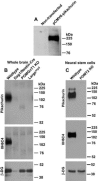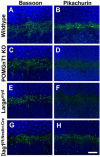Pikachurin interaction with dystroglycan is diminished by defective O-mannosyl glycosylation in congenital muscular dystrophy models and rescued by LARGE overexpression
- PMID: 21129441
- PMCID: PMC3018538
- DOI: 10.1016/j.neulet.2010.11.056
Pikachurin interaction with dystroglycan is diminished by defective O-mannosyl glycosylation in congenital muscular dystrophy models and rescued by LARGE overexpression
Abstract
Congenital muscular dystrophies (CMD) such as muscle-eye-brain disease caused by defective glycosylation of α-dystroglycan (α-DG) exhibit defective photoreceptor synaptic function. Mouse knockouts of dystroglycan and its extracellular matrix binding partner pikachurin recapitulate this phenotype. In this study, pikachurin-α-dystroglycan interactions in several mouse models of CMD were examined by pikachurin overlay experiments. The results show that hypoglycosylation of α-dystroglycan resulted in markedly reduced pikachurin-α-dystroglycan interactions. Expression of pikachurin is abolished at the outer plexiform layer of two mouse models, protein O-mannose N-acetylglucosaminyl transferase 1 (POMGnT1) knockout and Large(myd) mice. Overexpressing LARGE restored this interaction in POMGnT1 knockout cells. These results indicate that pikachurin interactions with α-dystroglycan and its localization at the photoreceptor ribbon synapse require normal glycosylation of α-dystroglycan.
Copyright © 2010 Elsevier Ireland Ltd. All rights reserved.
Figures




Similar articles
-
Presynaptic dystroglycan-pikachurin complex regulates the proper synaptic connection between retinal photoreceptor and bipolar cells.J Neurosci. 2012 May 2;32(18):6126-37. doi: 10.1523/JNEUROSCI.0322-12.2012. J Neurosci. 2012. PMID: 22553019 Free PMC article.
-
Post-translational maturation of dystroglycan is necessary for pikachurin binding and ribbon synaptic localization.J Biol Chem. 2010 Oct 8;285(41):31208-16. doi: 10.1074/jbc.M110.116343. Epub 2010 Aug 3. J Biol Chem. 2010. PMID: 20682766 Free PMC article.
-
Residual laminin-binding activity and enhanced dystroglycan glycosylation by LARGE in novel model mice to dystroglycanopathy.Hum Mol Genet. 2009 Feb 15;18(4):621-31. doi: 10.1093/hmg/ddn387. Epub 2008 Nov 18. Hum Mol Genet. 2009. PMID: 19017726 Free PMC article.
-
[Essential role of pikachurin, a novel dystroglycan-binding protein, in bipolar dendrite connection to photoreceptor ribbon synapse in the retina].Nippon Ganka Gakkai Zasshi. 2010 Nov;114(11):955-67. Nippon Ganka Gakkai Zasshi. 2010. PMID: 21141075 Review. Japanese.
-
Glycosylation with ribitol-phosphate in mammals: New insights into the O-mannosyl glycan.Biochim Biophys Acta Gen Subj. 2017 Oct;1861(10):2462-2472. doi: 10.1016/j.bbagen.2017.06.024. Epub 2017 Jul 12. Biochim Biophys Acta Gen Subj. 2017. PMID: 28711406 Review.
Cited by
-
The dynamic architecture of photoreceptor ribbon synapses: cytoskeletal, extracellular matrix, and intramembrane proteins.Vis Neurosci. 2011 Nov;28(6):453-71. doi: 10.1017/S0952523811000356. Vis Neurosci. 2011. PMID: 22192503 Free PMC article. Review.
-
Presynaptic dystroglycan-pikachurin complex regulates the proper synaptic connection between retinal photoreceptor and bipolar cells.J Neurosci. 2012 May 2;32(18):6126-37. doi: 10.1523/JNEUROSCI.0322-12.2012. J Neurosci. 2012. PMID: 22553019 Free PMC article.
-
The roles of dystroglycan in the nervous system: insights from animal models of muscular dystrophy.Dis Model Mech. 2018 Dec 19;11(12):dmm035931. doi: 10.1242/dmm.035931. Dis Model Mech. 2018. PMID: 30578246 Free PMC article. Review.
-
Identification of EGFLAM, SPATC1L and RNASE13 as novel susceptibility loci for aortic aneurysm in Japanese individuals by exome-wide association studies.Int J Mol Med. 2017 May;39(5):1091-1100. doi: 10.3892/ijmm.2017.2927. Epub 2017 Mar 21. Int J Mol Med. 2017. PMID: 28339009 Free PMC article.
-
Cell specific post-translational processing of pikachurin, a protein involved in retinal synaptogenesis.PLoS One. 2012;7(12):e50552. doi: 10.1371/journal.pone.0050552. Epub 2012 Dec 4. PLoS One. 2012. PMID: 23226524 Free PMC article.
References
-
- Ueda H, Gohdo T, Ohno S. Beta-dystroglycan localization in the photoreceptor and Muller cells in the rat retina revealed by immunoelectron microscopy. J. Histochem. Cytochem. 1998;46:185–191. - PubMed
-
- Schmitz F, Holbach M, Drenckhahn D. Colocalization of retinal dystrophin and actin in postsynaptic dendrites of rod and cone photoreceptor synapses. Histochemistry. 1993;100:473–479. - PubMed
-
- Cox GA, Phelps SF, Chapman VM, Chamberlain JS. New mdx mutation disrupts expression of muscle and nonmuscle isoforms of dystrophin. Nat. Genet. 1993;4:87–93. - PubMed
-
- Cibis GW, Fitzgerald KM, Harris DJ, Rothberg PG, Rupani M. The effects of dystrophin gene mutations on the ERG in mice and humans. Invest Ophthalmol. Vis. Sci. 1993;34:3646–3652. - PubMed
-
- Pillers DA, Weleber RG, Woodward WR, Green DG, Chapman VM, Ray PN. mdxCv3 mouse is a model for electroretinography of Duchenne/Becker muscular dystrophy. Invest Ophthalmol. Vis. Sci. 1995;36:462–466. - PubMed
Publication types
MeSH terms
Substances
Grants and funding
LinkOut - more resources
Full Text Sources
Molecular Biology Databases

